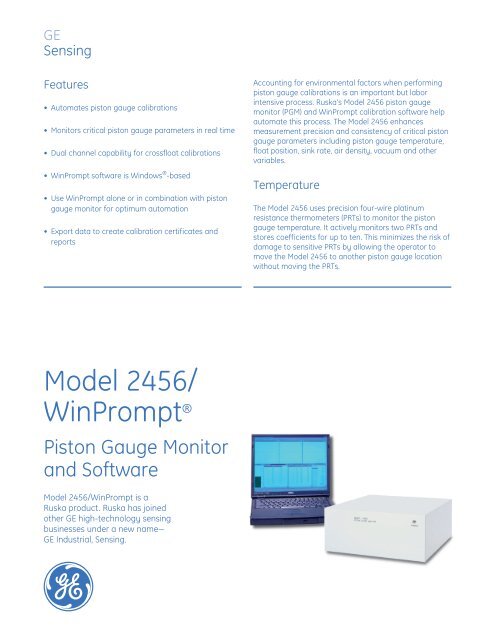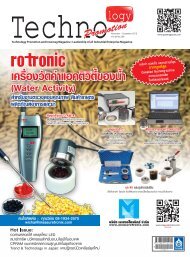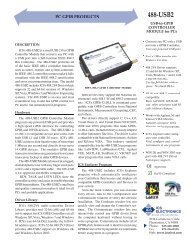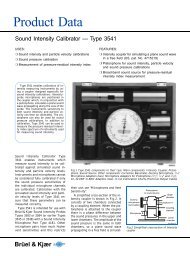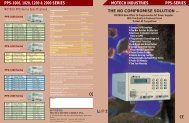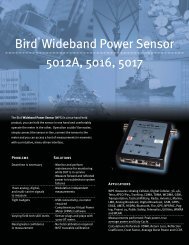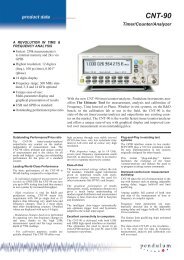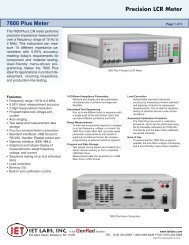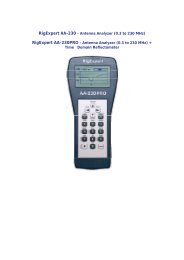Data Sheet
Data Sheet
Data Sheet
You also want an ePaper? Increase the reach of your titles
YUMPU automatically turns print PDFs into web optimized ePapers that Google loves.
GE<br />
Sensing<br />
Features<br />
• Automates piston gauge calibrations<br />
• Monitors critical piston gauge parameters in real time<br />
• Dual channel capability for crossfloat calibrations<br />
• WinPrompt software is Windows ® -based<br />
• Use WinPrompt alone or in combination with piston<br />
gauge monitor for optimum automation<br />
• Export data to create calibration certificates and<br />
reports<br />
Accounting for environmental factors when performing<br />
piston gauge calibrations is an important but labor<br />
intensive process. Ruska’s Model 2456 piston gauge<br />
monitor (PGM) and WinPrompt calibration software help<br />
automate this process. The Model 2456 enhances<br />
measurement precision and consistency of critical piston<br />
gauge parameters including piston gauge temperature,<br />
float position, sink rate, air density, vacuum and other<br />
variables.<br />
Temperature<br />
The Model 2456 uses precision four-wire platinum<br />
resistance thermometers (PRTs) to monitor the piston<br />
gauge temperature. It actively monitors two PRTs and<br />
stores coefficients for up to ten. This minimizes the risk of<br />
damage to sensitive PRTs by allowing the operator to<br />
move the Model 2456 to another piston gauge location<br />
without moving the PRTs.<br />
Model 2456/<br />
WinPrompt ®<br />
Piston Gauge Monitor<br />
and Software<br />
Model 2456/WinPrompt is a<br />
Ruska product. Ruska has joined<br />
other GE high-technology sensing<br />
businesses under a new name—<br />
GE Industrial, Sensing.<br />
g
GE<br />
Sensing<br />
Float Position<br />
Non-contact, inductive proximity sensors in the<br />
Model 2456 accurately read the float position of the<br />
piston gauge to a resolution of 0.001 in (0.025 mm), which<br />
is significantly greater than the readability of the unaided<br />
eye.<br />
Sink Rate<br />
Sink rate is often used as an accurate indication of<br />
thermal stability, and for detecting leaks in the system<br />
that result in pressure measurement errors. In crossfloat<br />
applications, sink rate becomes a high resolution<br />
indicator of the differential pressure existing between two<br />
piston gauges. Routinely monitoring the sink rate of your<br />
piston gauge promotes consistency and confidence in<br />
your pressure calibrations. The sink-rate-versus-time<br />
display is vital for evaluating system integrity and<br />
stability.<br />
Air Density<br />
The optional laboratory environment monitor (LEM)<br />
actively monitors relative humidity, barometric pressure,<br />
and ambient air temperature. The Model 2456 reads<br />
these signals and performs a real time computation of<br />
the density of the air surrounding the masses on the<br />
piston gauge. WinPrompt calibration software computes<br />
the buoyant effect of the ambient air on the piston gauge<br />
masses, and computes adjustments to the pressure or<br />
mass accordingly.<br />
Vacuum Module<br />
The optional vacuum module is typically used with the<br />
Model 2465 gas piston gauge when operating in absolute<br />
mode and monitoring the residual bell jar pressure is<br />
required. The 2456 allows real time monitoring of the<br />
vacuum and is used with WinPrompt to make<br />
appropriate corrections to the pressure-mass<br />
calculations.<br />
WinPrompt Calibration Software<br />
WinPrompt calibration software increases calibration<br />
efficiency by providing full-color, Windows-based<br />
measurement for your process. This easy-to-use<br />
software can be used independently or in conjunction<br />
with the Model 2456. In either instance, WinPrompt<br />
provides the capability for customizing calibration<br />
procedures and reports.<br />
<strong>Data</strong> Storage<br />
WinPrompt stores the calibration coefficients for your<br />
working standards, including piston/cylinder effective<br />
area, thermal coefficient of expansion, pressure<br />
deformation coefficients, and all calibrated mass values<br />
and associated density. It also stores all of the critical<br />
system and environmental parameters, including local<br />
gravity, head corrections, and air density.<br />
Calculations and Conversions<br />
WinPrompt performs all necessary calculations of<br />
pressure-to-mass and mass-to-pressure in both metric<br />
and English units. When using the Model 2456 and the<br />
LEM, WinPrompt computes the buoyant effect of the<br />
ambient air on the piston gauge masses, and<br />
compensates accordingly.<br />
Procedures<br />
WinPrompt provides the ability to create calibration<br />
procedures for performing repetitive type calibrations.<br />
Multiple pressure values can be created in a table and<br />
each window (i.e. float position, temperature) can be<br />
sized, positioned and saved as a procedure.This can be<br />
recalled anytime the calibration is being performed.<br />
Report Formatting<br />
Calibration reports can be exported in ASCII format and<br />
then imported into popular commercial spreadsheet and<br />
word processing software programs to generate<br />
customized, formal calibration reports. Set up your own<br />
calibration report templates in Microsoft Word ® , Excel ® ,<br />
or other popular programs, adding your organization’s<br />
logo and other information to simplify and automate<br />
professional looking reports.<br />
Units<br />
Select from the following units of measurement:<br />
• Temperature: ºF or ºC<br />
• Float position: in or cm<br />
• Barometric pressure: inHg, kPa, mbar, psi, kg/cm 2 ,<br />
mmHg, or cmHg<br />
• Vacuum: Hg or mTorr<br />
• Density: g/cm 3 , kg/m 3 , lb/in 3<br />
• Sink rate: in/min or cm/min
GE<br />
Sensing<br />
Model 2456/<br />
WinPrompt<br />
Specifications<br />
Model 2456<br />
Available in single or dual channel configuration using<br />
WinPrompt calibration software<br />
Electrical Power<br />
100–250 VAC, 50/60 Hz<br />
Temperature<br />
Operating temperature 64.4°F (18°C) to 96.8°F (36 °C)<br />
Storage Temperature<br />
-4°F to 158°F (-20°C to 70 °C)<br />
Humidity<br />
5 to 95% relative humidity, noncondensing<br />
Dimensions (h x w x d)<br />
4.2 in x 11.8 in x 9.9 in (106.68 mm x 299.72 mm x<br />
251.46 mm)<br />
Weight<br />
8.4 lb (3.81 kg)<br />
Float Position<br />
Sensor Type<br />
Inductive<br />
Resolution<br />
Sink rate: 0.001 in/min or 0.001 cm/min<br />
Float Position<br />
0.001 in or cm<br />
Number of Sensors<br />
One to four (up to two sensors per piston gauge, total of<br />
two piston gauges)<br />
Calibration Range<br />
Approximately 0.05 in to 0.75 in (0.13 cm to 1.9 cm)<br />
Piston/Cylinder Temperature<br />
Probe Type<br />
Four-wire 100 Ω PRT<br />
Resolution<br />
±0.1 °C<br />
Accuracy<br />
±0.1 °C (conforms with ITS-90)/year<br />
Number of Sensors<br />
One or two<br />
Calibration<br />
A calibration report providing traceability to National<br />
Institute of Standards and Technology (NIST) is provided<br />
with each PRT.<br />
Vacuum Module (Optional)<br />
Resolution<br />
1 mTorr<br />
Accuracy<br />
10% of reading or 10 mTorr, whichever is greater<br />
Number of Sensors<br />
One or two<br />
Sensor Type<br />
Silicon, micromachined thermal conductivity<br />
Calibration<br />
A calibration report providing traceability to NIST is<br />
provided with each vacuum module.<br />
Communications<br />
RS232 Interface
GE<br />
Sensing<br />
Model 2456/<br />
WinPrompt<br />
Specifications<br />
Laboratory Environment Monitor<br />
(Optional)<br />
Accuracy<br />
• Temperature: ±0.5 °C/year<br />
• Humidity: ±10% relative humidity/year<br />
• Pressure: ±2 mmHg/year<br />
Shown: WinPrompt is acquiring information from the piston gauge<br />
through the piston gauge monitor and displaying it in realtime. The data<br />
is being used to automatically adjust the pressure/mass values.<br />
Calibration<br />
A calibration report providing traceability to NIST is<br />
provided with each air density module LEM.<br />
WinPrompt Calibration Software<br />
Hardware Requirements<br />
Minimum 80386 33 MHz processor; 8MB RAM; program<br />
requires 2 MB available hard disk space and available<br />
RS232 Interface.<br />
Software Requirements<br />
Microsoft Windows version 3.1 or later. Also compatible<br />
with Windows NT.<br />
Shown: the WinPrompt calibration screen displays calibration values and<br />
allows for user comments. Export this information using dynamic data<br />
exchange (DDE) into your favorite word processing or spreadsheet<br />
program to create calibration certificates and reports.<br />
g<br />
©2005<br />
GE. All rights reserved.<br />
920-231A<br />
All specifications are subject to change for product improvement without notice.<br />
WinPrompt ® is a registered trademark of GE. GE ® is a registered trademark of<br />
General Electric Co. Excel ® , Windows ® and Word ® are registered trademarks of<br />
Microsoft Corporation, which are not affiliated with GE, in the U.S. and other<br />
countries. Other company or product names mentioned in this document may be<br />
trademarks or registered trademarks of their respective companies, which are not<br />
affiliated with GE.<br />
www.gesensing.com<br />
®


